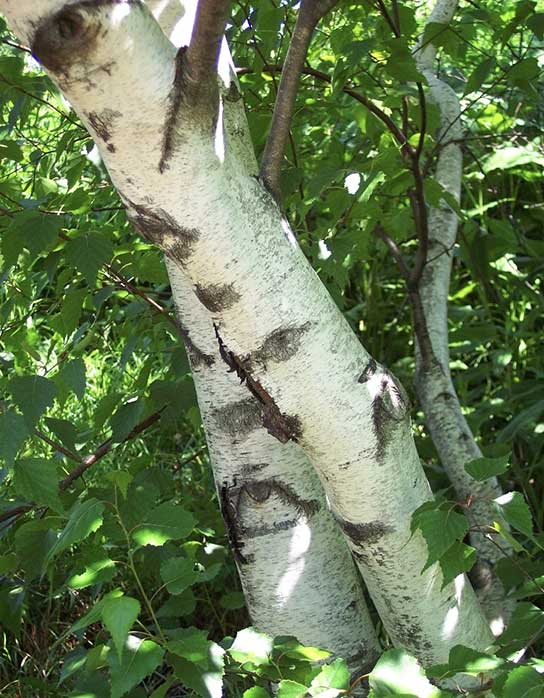betula
Betula Whitespire Birch
The Betula ‘Whitespire’ Birch, commonly known as Whitespire Birch, is a striking ornamental tree prized for its elegant form, attractive bark, and adaptability to various landscapes. It is a cultivar of the Betula populifolia species, often referred to as the Gray Birch, though Whitespire is distinct for its refined characteristics and improved resilience. Developed by Dr. Edward R. Hasselkus at the University of Wisconsin-Madison, this tree was selected for its superior qualities and introduced as a standout option for gardeners and landscapers.
Appearance and Features
Whitespire Birch is most celebrated for its brilliant white bark, which peels away in thin layers to reveal a smooth, chalky surface underneath. Unlike some other birches, such as the Paper Birch (Betula papyrifera), Whitespire’s bark tends to remain consistently white and resists darkening with age, lending it a clean, bright aesthetic year-round. The tree typically grows to a height of 30 to 40 feet, with a spread of about 20 to 25 feet, forming a narrow, pyramidal to oval canopy that provides a graceful silhouette.
Its leaves are triangular to diamond-shaped, with serrated edges, and turn a vibrant yellow in the fall, adding seasonal interest. In spring, the tree produces small, inconspicuous flowers in the form of catkins, which are followed by tiny winged seeds that disperse with the wind. The foliage is a glossy medium green during the growing season, creating a lovely contrast with the white bark.
Growing Conditions
Whitespire Birch is relatively easy to grow and adaptable to a range of conditions, making it a popular choice for urban and suburban settings. It thrives in full sun to partial shade and prefers moist, well-drained soils, though it can tolerate a variety of soil types, including sandy or clay-heavy compositions. The tree is hardy in USDA zones 3 to 7, meaning it can withstand cold winters and moderate summers. While it enjoys consistent moisture, it’s more drought-tolerant than many other birch varieties once established, though prolonged dry spells may stress the tree.
One of its standout traits is its resistance to bronze birch borer, a common pest that plagues many birch species, particularly Paper Birch. This resistance, combined with its tolerance of urban pollution, makes Whitespire a reliable choice for landscapes where other birches might struggle.
Uses in Landscaping
Whitespire Birch is a versatile tree that shines in both solitary and group plantings. As a specimen tree, its white bark and airy canopy make it a focal point in lawns or gardens. Planted in clusters or rows, it can create a natural screen or windbreak. Its relatively compact size compared to other birches also makes it suitable for smaller yards or near patios, where larger trees might overwhelm the space. The tree’s delicate leaves and open branching patterns allow for underplanting with shade-tolerant perennials or shrubs, enhancing its visual appeal.
Care and Maintenance
While low-maintenance overall, Whitespire Birch benefits from some basic care. Regular watering during its first few years helps establish a strong root system, especially in dry climates. Pruning is minimal, typically limited to removing dead or damaged branches, and should be done in late fall or winter to avoid sap bleeding. Mulching around the base can help retain moisture and protect the shallow roots, which are sensitive to compaction and heat.
Potential issues include susceptibility to leaf spot or aphids, though these are rarely severe enough to threaten the tree’s health. Its resistance to bronze birch borer is a significant advantage, but monitoring for stress (e.g., from drought or poor drainage) can prevent secondary pest problems.
Ecological and Aesthetic Value
Beyond its beauty, Whitespire Birch supports local wildlife to a modest degree. Birds may use it for nesting, and its seeds provide a minor food source for small animals. Aesthetically, it evokes a sense of timeless elegance, often associated with northern woodlands, yet fits seamlessly into modern landscapes.
In summary, the Betula ‘Whitespire’ Birch is a refined and resilient tree that combines classic birch charm with practical advantages. Whether you’re looking to enhance a garden with its luminous bark or seeking a hardy, pest-resistant option for a challenging site, Whitespire is a standout choice that delivers beauty and reliability in equal measure.
Height: 30′ – 40′
Width: 15′ – 20′
Exposure: Full sun.
Fruit / Flower: Nutlett 1″2″ / catkins.
Fall Color: Yellow.
Water: This Whitespire variety tolerates heat, wind and drought. It does not like constantly wet soil (unlike the river Birch).
Fertilizer: Use a general fertilizer once a year just before new growth.
Pruning: Prune in late fall. Avoid early spring pruning while the sap is running. Prune lightly.
Category: Trees – Whitespire Birch near me – Betula Platyphylla – Birch

